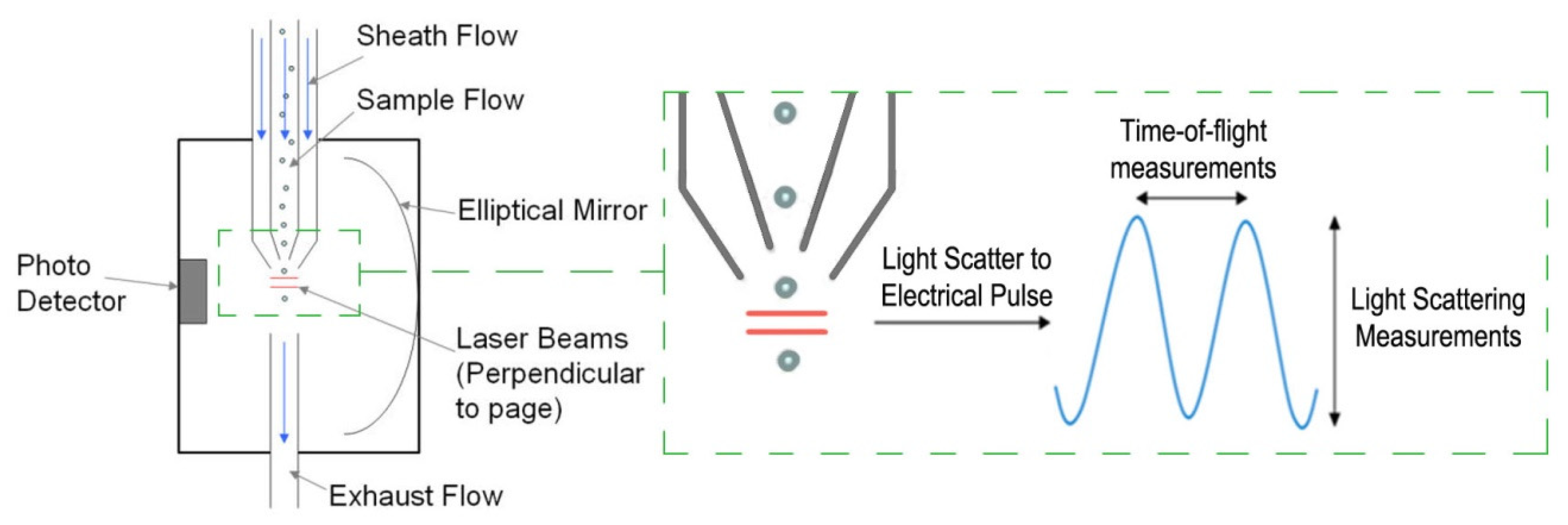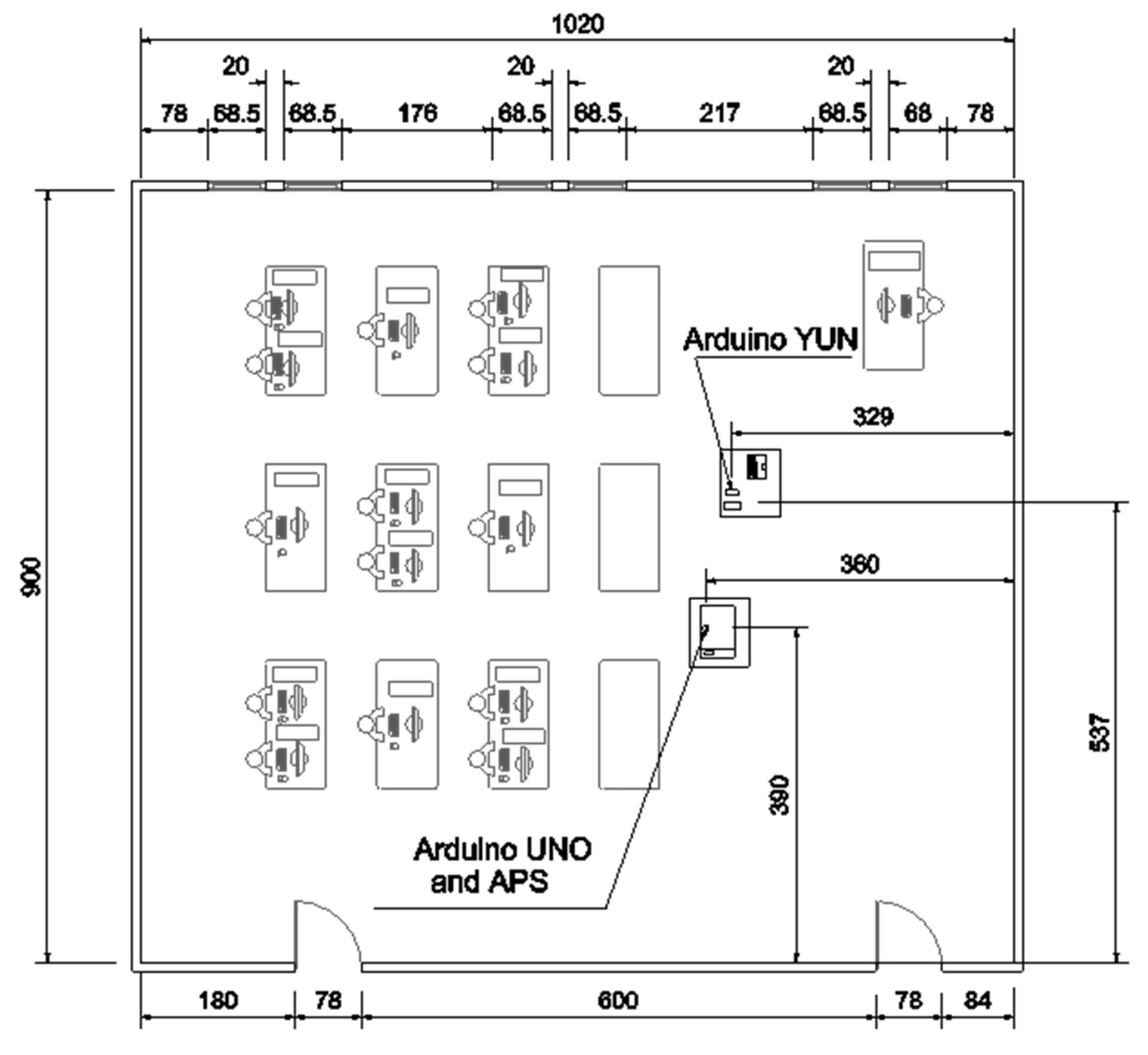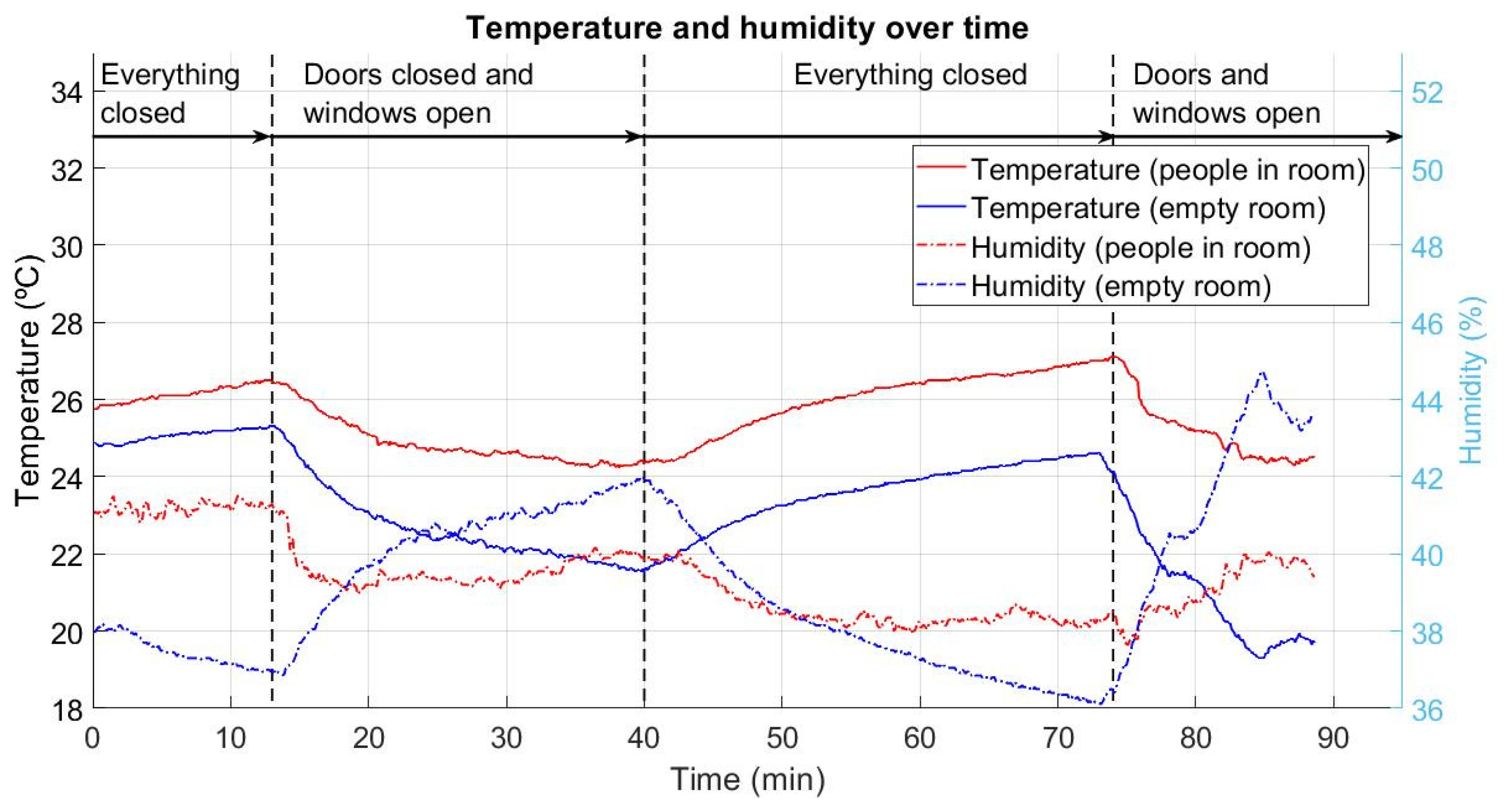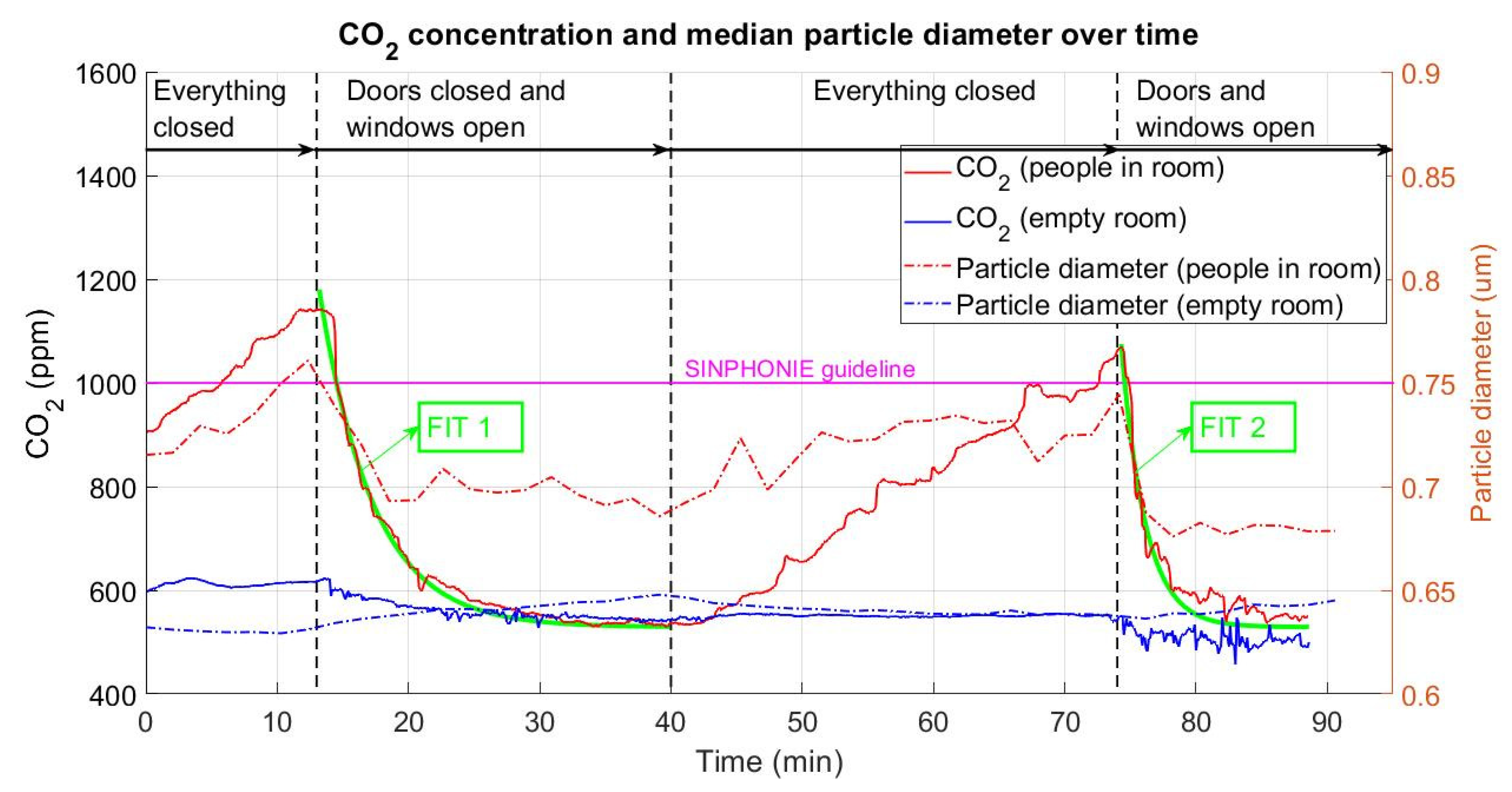Natural Ventilation Characterization in a Classroom under Different Scenarios
Abstract
1. Introduction
2. Materials and Methods
3. Results
3.1. Temperature and Humidity
3.2. CO2 Concentration and Median Particle Diameter
3.3. Particulate Matter 2.5 and Particle Concentration
4. Conclusions
- The temperature showed the same behavior in both cases (people in room and empty room). In the empty room case, the temperature was 1.5–3 °C lower. Natural ventilation cooled the room by 2–4 °C, depending on the occupancy and ventilation rate.
- The relative humidity results revealed a tendency towards equilibrium. The equilibrium point varied according to the ventilation conditions. After opening the windows, the RH readjusted to reflect the external conditions. This reconditioning is more significant at higher ventilation rates.
- In terms of CO2 concentration, a linear time increase was observed in the no-ventilation situation with people inside. This can be explained by the fact that the main CO2 source was the subjects. In both ventilation situations, an asymptotic decrease 570 ppm of CO2. Note that this value is close to the continuous one in the empty room scenario. In 15 min of ventilation with windows open, the CO2 minimum value was reached, versus within 5 min with both doors and windows open.
- The particles’ median diameter size showed a similar trend to the CO2 concentration. The median particle diameter size increased during no-ventilation situations and decreased significantly during ventilation states, especially at higher ventilation ratios.
- Finally, particulate matter PM2.5 and particle concentration were studied. Both parameters follow a similar trend during the time of experiment. Initially, with a no-ventilation, a decrease in both PM2.5 and particle concentration were observed. On the other hand, when natural ventilation was applied, a noticeable increase was found.
Author Contributions
Funding
Institutional Review Board Statement
Informed Consent Statement
Data Availability Statement
Acknowledgments
Conflicts of Interest
References
- Hafner, C.M. The Spread of the Covid-19 Pandemic in Time and Space. Int. J. Environ. Res. Public Health 2020, 17, 3827. [Google Scholar] [CrossRef] [PubMed]
- Hasnain, M.; Pasha, M.F.; Ghani, I. Combined Measures to Control the COVID-19 Pandemic in Wuhan, Hubei, China: A Narrative Review. J. Biosaf. Biosecurity 2020, 2, 51–57. [Google Scholar] [CrossRef]
- Oliver, S.E.; Gargano, J.W.; Marin, M.; Wallace, M.; Curran, K.G.; Chamberland, M.; McClung, N.; Campos-Outcalt, D.; Morgan, R.L.; Mbaeyi, S.; et al. The Advisory Committee on Immunization Practices’ Interim Recommendation for Use of Pfizer-BioNTech COVID-19 Vaccine-United States, December 2020. MMWR Morb. Mortal. Wkly. Rep. 2020, 69, 1922–1924. [Google Scholar] [CrossRef]
- Engelbrecht, F.A.; Scholes, R.J. Test for Covid-19 Seasonality and the Risk of Second Waves. One Health Amst. Neth. 2021, 12, 100202. [Google Scholar] [CrossRef]
- Renardy, M.; Eisenberg, M.; Kirschner, D. Predicting the Second Wave of COVID-19 in Washtenaw County, MI. J. Theor. Biol. 2020, 507, 110461. [Google Scholar] [CrossRef]
- Wang, R.; Xiong, Y.; Xing, X.; Yang, R.; Li, J.; Wang, Y.; Cao, J.; Balkanski, Y.; Penuelas, J.; Ciais, P.; et al. Daily CO2 Emission Reduction Indicates the Control of Activities to Contain COVID-19 in China. Innovation 2020, 1. [Google Scholar] [CrossRef]
- Schibuola, L.; Tambani, C. High Energy Efficiency Ventilation to Limit COVID-19 Contagion in School Environments. Energy Build. 2021, 240, 110882. [Google Scholar] [CrossRef]
- Alcamí, A.; Querol, X.; Robustillo, A.; Valencia, A. Informe Científico Sobre Vías de Transmisión SARS-CoV-2; The Ministry of Science and Innovation: Madrid, Spain, 2020; Volume 25. [Google Scholar]
- Zhang, R.; Li, Y.; Zhang, A.L.; Wang, Y.; Molina, M.J. Identifying Airborne Transmission as the Dominant Route for the Spread of COVID-19. Proc. Natl. Acad. Sci. USA 2020, 117, 14857–14863. [Google Scholar] [CrossRef] [PubMed]
- Qian, H.; Miao, T.; Liu, L.; Zheng, X.; Luo, D.; Li, Y. Indoor Transmission of SARS-CoV-2. medRxiv 2020. [Google Scholar] [CrossRef]
- Bartyzel, J.; Zięba, D.; Nęcki, J.; Zimnoch, M. Assessment of Ventilation Efficiency in School Classrooms Based on Indoor–Outdoor Particulate Matter and Carbon Dioxide Measurements. Sustainability 2020, 12, 5600. [Google Scholar] [CrossRef]
- Persily, A.K. Indoor Carbon Dioxide Concentrations in Ventilation and Indoor Air Quality Standards. In Proceedings of the 36th AIVC, Conference on Effective Ventilation in High Performance Buildings, Madrid, Spain, 23–24 September 2015. [Google Scholar]
- Hou, Y.; Liu, J.; Li, J. Investigation of Indoor Air Quality in Primary School Classrooms. Procedia Eng. 2015, 121, 830–837. [Google Scholar] [CrossRef]
- Rumchev, K.; Zhao, Y.; Spickett, J. Health Risk Assessment of Indoor Air Quality, Socioeconomic and House Characteristics on Respiratory Health among Women and Children of Tirupur, South India. Int. J. Environ. Res. Public Health 2017, 14, 429. [Google Scholar] [CrossRef] [PubMed]
- Morawska, L.; Tang, J.W.; Bahnfleth, W.; Bluyssen, P.M.; Boerstra, A.; Buonanno, G.; Cao, J.; Dancer, S.; Floto, A.; Franchimon, F.; et al. How Can Airborne Transmission of COVID-19 Indoors Be Minimised? Environ. Int. 2020, 142, 105832. [Google Scholar] [CrossRef] [PubMed]
- Pulimeno, M.; Piscitelli, P.; Colazzo, S.; Colao, A.; Miani, A. Indoor Air Quality at School and Students’ Performance: Recommendations of the UNESCO Chair on Health Education and Sustainable Development & the Italian Society of Environmental Medicine (SIMA). Health Promot. Perspect. 2020, 10. [Google Scholar] [CrossRef]
- Dinh, T.-V.; Lee, J.-Y.; Ahn, J.-W.; Kim, J.-C. Development of a Wide-Range Non-Dispersive Infrared Analyzer for the Continuous Measurement of CO2 in Indoor Environments. Atmosphere 2020, 11, 1024. [Google Scholar] [CrossRef]
- Bhagat, R.K.; Wykes, M.S.D.; Dalziel, S.B.; Linden, P.F. Effects of Ventilation on the Indoor Spread of COVID-19. J. Fluid Mech. 2020, 903. [Google Scholar] [CrossRef]
- Wang, Y.; Zhao, F.-Y.; Kuckelkorn, J.; Spliethoff, H.; Rank, E. School Building Energy Performance and Classroom Air Environment Implemented with the Heat Recovery Heat Pump and Displacement Ventilation System. Appl. Energy 2014, 114, 58–68. [Google Scholar] [CrossRef]
- Li, J.; Hou, Y.; Liu, J.; Wang, Z.; Li, F. Window Purifying Ventilator Using a Cross-Flow Fan: Simulation and Optimization. Build. Simul. 2016, 9, 481–488. [Google Scholar] [CrossRef]
- Domínguez-Amarillo, S.; Fernández-Agüera, J.; Cesteros-García, S.; González-Lezcano, R.A. Bad Air Can Also Kill: Residential Indoor Air Quality and Pollutant Exposure Risk during the COVID-19 Crisis. Int. J. Environ. Res. Public Health 2020, 17, 7183. [Google Scholar] [CrossRef]
- Satish, U.; Mendell, M.J.; Shekhar, K.; Hotchi, T.; Sullivan, D.; Streufert, S.; Fisk, W.J. Is CO2 an Indoor Pollutant? Direct Effects of Low-to-Moderate CO2 Concentrations on Human Decision-Making Performance. Environ. Health Perspect. 2012, 120, 1671. [Google Scholar] [CrossRef]
- Chillón, S.A.; Ugarte-Anero, A.; Aramendia, I.; Fernandez-Gamiz, U.; Zulueta, E. Numerical Modeling of the Spread of Cough Saliva Droplets in a Calm Confined Space. Mathematics 2021, 9, 574. [Google Scholar] [CrossRef]
- Dbouk, T.; Drikakis, D. On Coughing and Airborne Droplet Transmission to Humans. Phys. Fluids 2020, 32. [Google Scholar] [CrossRef] [PubMed]
- Dbouk, T.; Drikakis, D. On Respiratory Droplets and Face Masks. Phys. Fluids 2020, 32. [Google Scholar] [CrossRef] [PubMed]
- Feng, Y.; Marchal, T.; Sperry, T.; Yi, H. Influence of Wind and Relative Humidity on the Social Distancing Effectiveness to Prevent COVID-19 Airborne Transmission: A Numerical Study. J. Aerosol Sci. 2020, 147, 105585. [Google Scholar] [CrossRef]
- Aliabadi, A.A.; Rogak, S.N.; Green, S.I.; Bartlett, K.H. CFD Simulation of Human Coughs and Sneezes: A Study in Droplet Dispersion, Heat, and Mass Transfer. In Proceedings of the Volume 7: Fluid Flow, Heat Transfer and Thermal Systems, Parts A and B, ASMEDC, Vancouver, BC, Canada, 1 January 2010; pp. 1051–1060. [Google Scholar]
- Vuorinen, V.; Aarnio, M.; Alava, M.; Alopaeus, V.; Atanasova, N.; Auvinen, M.; Balasubramanian, N.; Bordbar, H.; Erästö, P.; Grande, R.; et al. Modelling Aerosol Transport and Virus Exposure with Numerical Simulations in Relation to SARS-CoV-2 Transmission by Inhalation Indoors. Saf. Sci. 2020, 130, 104866. [Google Scholar] [CrossRef]
- Yang, X.; Ou, C.; Yang, H.; Liu, L.; Song, T.; Kang, M.; Lin, H.; Hang, J. Transmission of Pathogen-Laden Expiratory Droplets in a Coach Bus. J. Hazard. Mater. 2020, 397, 122609. [Google Scholar] [CrossRef] [PubMed]
- Shao, S.; Zhou, D.; He, R.; Li, J.; Zou, S.; Mallery, K.; Kumar, S.; Yang, S.; Hong, J. Risk Assessment of Airborne Transmission of COVID-19 by Asymptomatic Individuals under Different Practical Settings. J. Aerosol Sci. 2021, 151, 105661. [Google Scholar] [CrossRef]
- Aramendia, I.; Fernandez-Gamiz, U.; Lopez-Arraiza, A.; Rey-Santano, C.; Mielgo, V.; Basterretxea, F.; Sancho, J.; Gomez-Solaetxe, M. Experimental and Numerical Modeling of Aerosol Delivery for Preterm Infants. Int. J. Environ. Res. Public Health 2018, 15, 423. [Google Scholar] [CrossRef]
- Pfeifer, S.; Müller, T.; Weinhold, K.; Zikova, N.; Martins dos Santos, S.; Marinoni, A.; Bischof, O.F.; Kykal, C.; Ries, L.; Meinhardt, F.; et al. Intercomparison of 15 Aerodynamic Particle Size Spectrometers (APS 3321): Uncertainties in Particle Sizing and Number Size Distribution. Atmos. Meas. Tech. 2016, 9, 1545–1551. [Google Scholar] [CrossRef]
- Chen, L.; Mao, J.; Zhao, H.; Zhou, C.; Gong, X. Size Distribution and Concentration of Aerosol Particles in Yinchuan Area, China. Phys. Geogr. 2019, 40, 538–553. [Google Scholar] [CrossRef]
- Csobod, E.; Annesi-Maesano, I.; Carrer, P.; Kephalopoulos, S.; Madureira, J.; Rudnai, P.; De Oliveira Fernandes, E.; Barrero, J.; Beregszászi, T.; Hyvärinen, A. SINPHONIE–Schools Indoor Pollution and Health Observatory Network in Europe-Final Report; Publications Office of the European Union: Luxembourg, 2014; ISBN 978-92-79-39407-2. EUR 26738. [Google Scholar] [CrossRef]
- van Doremalen, N.; Bushmaker, T.; Morris, D.H.; Holbrook, M.G.; Gamble, A.; Williamson, B.N.; Tamin, A.; Harcourt, J.L.; Thornburg, N.J.; Gerber, S.I.; et al. Aerosol and Surface Stability of SARS-CoV-2 as Compared with SARS-CoV-1. N. Engl. J. Med. 2020, 382, 1564–1567. [Google Scholar] [CrossRef]
- Lelieveld, J.; Helleis, F.; Borrmann, S.; Cheng, Y.; Drewnick, F.; Haug, G.; Klimach, T.; Sciare, J.; Su, H.; Pöschl, U. Model Calculations of Aerosol Transmission and Infection Risk of COVID-19 in Indoor Environments. Int. J. Environ. Res. Public Health 2020, 17, 8114. [Google Scholar] [CrossRef] [PubMed]
- Zheng, H.-L.; Deng, W.-J.; Cheng, Y.; Guo, W. Characteristics of PM2.5, CO2 and Particle-Number Concentration in Mass Transit Railway Carriages in Hong Kong. Environ. Geochem. Health 2017, 39, 739–750. [Google Scholar] [CrossRef]
- Lazovic, I.; Jovasevic-Stojanovic, M.; Zivkovic, M.; Tasic, V.; Stevanovic, Z. PM and CO2 Variability and Relationship in the Different School Environments. CI CEQ 2015, 21, 179–187. [Google Scholar] [CrossRef]
- Setti, L.; Passarini, F.; De Gennaro, G.; Barbieri, P.; Pallavicini, A.; Ruscio, M.; Piscitelli, P.; Colao, A.; Miani, A. Searching for SARS-COV-2 on Particulate Matter: A Possible Early Indicator of COVID-19 Epidemic Recurrence. Int. J. Environ. Res. Public Health 2020, 17, 2986. [Google Scholar] [CrossRef]






| No. | Measurement Day | Measurement Period | Classroom | Ventilation System | Classroom Occupancy | Temperature Outside | Relative Humidity Outside |
|---|---|---|---|---|---|---|---|
| 1 | 27 November 2020 | 9:29–10:59 | Info 1.3 | natural | 15 | 6 °C | 79% |
| 2 | 30 November 2020 | 17:04–18:34 | Info 1.3 | natural | 0 | 7 °C | 100% |
| FIT | Confidence Bound | RMSE | |||
|---|---|---|---|---|---|
| FIT 1 | 24.83 | −1.897 | 95% | 0.9897 | 15.33 |
| FIT 2 | 11.13 | −2.271 | 95% | 0.9595 | 24.34 |
Publisher’s Note: MDPI stays neutral with regard to jurisdictional claims in published maps and institutional affiliations. |
© 2021 by the authors. Licensee MDPI, Basel, Switzerland. This article is an open access article distributed under the terms and conditions of the Creative Commons Attribution (CC BY) license (https://creativecommons.org/licenses/by/4.0/).
Share and Cite
Chillon, S.A.; Millan, M.; Aramendia, I.; Fernandez-Gamiz, U.; Zulueta, E.; Mendaza-Sagastizabal, X. Natural Ventilation Characterization in a Classroom under Different Scenarios. Int. J. Environ. Res. Public Health 2021, 18, 5425. https://doi.org/10.3390/ijerph18105425
Chillon SA, Millan M, Aramendia I, Fernandez-Gamiz U, Zulueta E, Mendaza-Sagastizabal X. Natural Ventilation Characterization in a Classroom under Different Scenarios. International Journal of Environmental Research and Public Health. 2021; 18(10):5425. https://doi.org/10.3390/ijerph18105425
Chicago/Turabian StyleChillon, Sergio A., Mikel Millan, Iñigo Aramendia, Unai Fernandez-Gamiz, Ekaitz Zulueta, and Xabier Mendaza-Sagastizabal. 2021. "Natural Ventilation Characterization in a Classroom under Different Scenarios" International Journal of Environmental Research and Public Health 18, no. 10: 5425. https://doi.org/10.3390/ijerph18105425
APA StyleChillon, S. A., Millan, M., Aramendia, I., Fernandez-Gamiz, U., Zulueta, E., & Mendaza-Sagastizabal, X. (2021). Natural Ventilation Characterization in a Classroom under Different Scenarios. International Journal of Environmental Research and Public Health, 18(10), 5425. https://doi.org/10.3390/ijerph18105425







